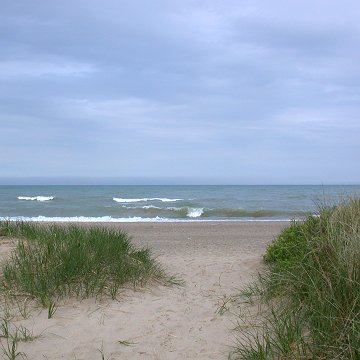

Ammophila breviligulata - (image 1 of 4)
Taxonomy
Family: Poaceae
Habitat
Dunes and sandy shores, usually near the beach where the sand is actively moving.
Associates
On beaches in the Great Lakes it occurs with Calamovilfa longifolia, Cakile edentula, and Corispermum hyssopifolium
Distribution
Great Lakes, Lake Champlain, and the Atlantic coast from New England to NC.
Morphology
Perennial grass to 1 m. Culms and sheaths glabrous; ligules 1-3 mm, ovate or truncate; blades to 8 mm wide, scabrous above. Inflorescence dense, to 40 cm long; glumes subequal, to 1.5 cm long, scabrous on the keel or throughout; lemma shorter than the glumes; awn 2 mm, hairy.
Notes
Flowers July to September
Wetland Indicator: Upland
This is an important species for dune stabilization. A related marram grass introduced from Europe, A. arenaria (L.) Link, sometimes occurs with this species on dunes. It has more glaucous leaves and a ligule longer than 1 cm.
References
Gleason, Henry A.
and A. Cronquist. 1991. Manual of Vascular Plants of Northeastern United States
and Adjacent Canada. Second Ed.
The New York Botanical Garden. Bronx, NY
Swink, F. and G.
Wilhelm. 1994. Plants of the Chicago Region.
Indiana Academy of Science. The Morton Arboretum. Lisle, Illinois.
|
© Michael Hough 2004 |